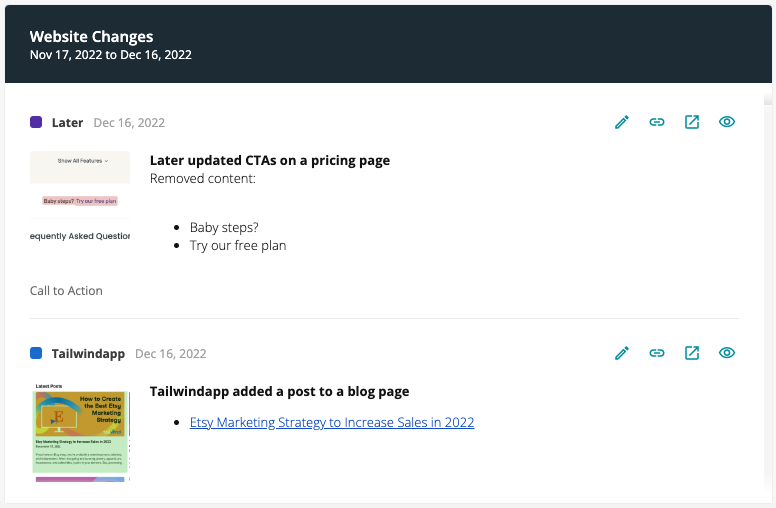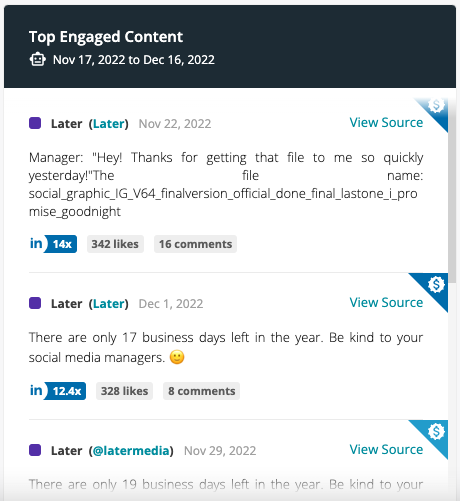Go into product marketing, they said. It will be fun, they said. Turns out you believed them - and they were mostly right. Just like any line of work it has its challenges, though, and one that product marketers always deal with is a lack of time to get everything done.
Now that layoffs are daily in the news and hiring freezes are everywhere, it's likely that your plate, which was already overflowing, is about to get even more full (is that possible?).
So, what's a conscientious product marketing manager to do? Ease up on competitor research and reporting until the competition overtakes you with new features, campaigns, and pricing changes? Never!
Until cloning gets a whole lot better or your hiring budgets open up, you're going to need some help. This is where automation shines. In fact, once you try it, you'll never want to go back to spending hours each week scanning social, keeping an eye on review sites, and trying to remember if that messaging on the competitor's home page is the same today as it was last week (and if not, what WAS it?).
With competitive intelligence (CI) automation, you'll get better insights in about the time it takes to enjoy that second cup of coffee, check your email, or catch up on Slack. Or maybe less. In fact, many users of automated CI say that what used to take days now takes about an hour a week.
Set up Your Competitor Data Collection
First, you'll need an automated competitor intelligence tool like Kompyte (of course). Your dedicated customer success representative will set it up with you. The sources your automated research will scour are the same ones you used to look at manually. That is, when you had a chance!
Website – the most obvious source of insight may also contain the most information. Get an idea of your competition's messaging, CTAs, pricing and promotions, as well as feature lists. You can begin comparing your product offering to theirs and get an idea of potential ways to win a sale against them. Pay close attention to changes on key pages.

Company Communications – While you’re on their website, sign up for any newsletters or communications they offer. This will give you further insight into how they speak with customers and allows you to be one of the first to know if they launch a promotion or new product features.
News – Press releases and other announcements are an excellent resource for tracking new product offerings or other big company updates such as partnerships or major personnel and leadership changes.
Social Media – Luckily, the best sources of competitive information, like social media, are public. Look at which updates or themes seem to resonate with their audience (which is likely similar to yours). Use this insight to generate new content ideas. Notice, too, how they interact with their customers and respond to feedback, which can help you differentiate yourself.
Ads – Are your competitors investing in PPC campaigns on AdWords and Facebook? Take a look at what they’re advertising and which landing pages they are focusing on. Take note of their headlines or any creative CTA they have included. This presents another opportunity to discover ideas for your own future PPC campaigns.
Blogs – Another place to find your competition is on their blog. Blogs give you an idea of the best performing content in your industry. Notice which topics receive the most interactions. Do they present a unique content type that receives better than average engagement, such as infographics? Even details such as how often they update can be beneficial. If your blog is not receiving the interactions you hope for, consider testing their strategy and integrating the learnings into your own marketing plan.
Obviously, this process can be done manually. The only issue is that it’s extremely time consuming. However, using a platform like Kompyte, you can take advantage of software that enables you to automatically track your competition’s web pages, social media, blog posts, and search ads. The platform will scan and report real-time changes. It even provides a side-by-side comparison, so you never have to ask “Was that there last week?” We also recommend using Kompyte’s notes feature to keep track of important insights you’ve identified or marketing tests you’d like to try.
Update SEO Landing Pages & AdWords Campaigns with New Keywords
Start experimenting with your competitors’ most successful keywords. Remember you won’t know what works until you try it.
Testing multiple keywords will help you discover the best options to improve your company’s AdWords campaigns and SEO performance.
Automate Alerts, Benchmarks and Battle Cards
Next, set up customized Alerts and receive them directly in your inbox. You’ll never be caught off guard by a competitor’s promotion again.
Benchmark your social media KPIs and online content engagement against your competition. Be wary of setting an engagement or growth rate that is too steep for your industry. We always encourage ambitious goals, but take a look at the competition to determine realistic goals.
Create custom reports to see data on any relevant competitor update, such as features, product updates, or even social media engagement. Custom reports can help you make decisions about specific business goals. You have the ability to ask a question, and then run a report to gather the data. It’s the smartest way to make decisions.
The Kompyte platform is a one-spot location for all competitor related tasks – including Battle Cards. If you notice a change, inform your sales team with 1-click Battle Card updates. This will enable your sales team to see the changes and instantly be prepared for their next sales meeting.
How to Calculate the Value?
Besides the extra time (hours!) you’ve gained with this new platform, how can we calculate the ROI? You can calculate the value of the data the platform has helped you discover by launching new strategic campaigns. You can also look into improving your search ad strategy, optimizing your landing pages to increase conversion, or feeding your editorial calendar with winning content. Well done, you deserve a raise!
For more tactics to increase your marketing performance visit our Academy